Finance-focused COP29 meeting begins, push for nuclear continues

As COP29 kicked off November 11, industry advocates worldwide are hoping to draw attention and increase buy-in to the need for more nuclear capacity.
The annual international gathering—the Conference of Parties—is the decision-making body of the United Nations' convention on climate change. This year’s session is being held in Baku, Azerbaijan, through November 22.
The group’s goals include reducing greenhouse gas emissions, building resiliency to climate-related impacts, promoting sustainable practices, and implementing policies and initiatives to transition to low-carbon economies, as outlined on the COP29 website. The primary focus of this year’s summit is how to deliver more and better financing to the countries that need it soonest.
Background: Coming out of last year’s COP28 meeting, dozens of nations signed an ambitious pledge to triple nuclear capacity worldwide by 2050.
Now, international leaders want to figure out how countries can pay for the nuclear investment. For the first time in 15 years, countries will revisit the amount and type of financing that developing countries receive to pay for climate action, the World Resource Institute (WRI) explained.
“Setting a more ambitious goal will be essential to helping vulnerable countries adopt clean energy and other low-carbon solutions and build resilience to worsening climate impacts,” according to the WRI.
IAEA involvement: The International Atomic Energy Agency’s Atoms4Climate pavilion at COP29 is showcasing nuclear science and technology solutions for climate change mitigation. It also serves as a space for government leaders, associations, civil society, academia, and media to amplify innovative ideas for nuclear science and technology solutions.
“At COP28, the world agreed nuclear power must be part of the transition to net zero,” said Rafael Mariano Grossi, director general of the IAEA, in the runup to COP29. “We know investment in nuclear power can lower grid costs and speed up the deployment of intermittent clean-energy sources like wind and solar. As the world moves from consensus to construction, the IAEA supports newcomer countries in establishing safe, secure, safeguarded and sustainable nuclear power programs.”
A UN report released on October 28 shows that current policies and investments fall far short of what is needed to keep global temperature rise below 1.5°C in this century, the target of the Paris Agreement adopted in 2015.
Impact of no-shows: President Joe Biden and other key world leaders are not attending COP29, fueling concern over the lasting impact of the meeting and its outcomes.
Those skipping the conference include European Commission president Ursula von der Leyen, Brazil’s president Luiz Inácio Lula da Silva, India’s prime minister Narendra Modi, China’s president Jinping Xi, French president Emmanuel Macron, and German chancellor Olaf Scholz.
Only two leaders from the G7—U.K. prime minister Keir Starmer and Italy’s prime minister Giorgia Meloni—are expected at COP29.






